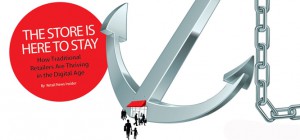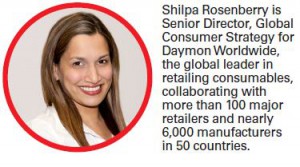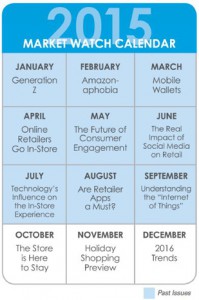By Retail News Insider
“Five Trends Driving Traditional Retail Toward Extinction” —Forbes
“Retail Stores Will Completely Die, Says Tech Investor” —Business Insider
“Is brick and mortar retail in a death spiral?”—Fortune
 Your favorite stores are going to close.
Your favorite stores are going to close.
Not really, but as the headlines above show, that’s what some retail insiders would have you believe. In reality, for many retailers, this doom and gloom scenario is quite far from the truth. Many big-name traditional retailers are clearly thriving, and several popular online-only retailers, such as Bonobos and Warby Parker, have also started to explore the benefits of a physical presence with special pop-up stores or boutique collaborations. But that doesn’t mean stores can get by with the status quo. The question every brick-and-mortar retailer needs to ask is: What does it take to stay relevant in today’s retail environment? And what will the future bring for the in-store experience?
We asked three retail experts to share their cutting-edge insights and this is what they had to offer:

Align with Consumer Needs
“People have so many places to shop. Online shopping coupled with the rise of subscription services, food delivery services—all of those are taking the sales out of stores,” admits Shilpa Rosenberry, Senior Director, Global Consumer Strategy for Daymon Worldwide.
“But the majority of consumer spending is still done in physical stores,” Rosenberry emphasizes. “In some ways they are even more relevant than ever. This is seen in pure play retailers opening physical locations across the country. Despite the fragmentation, the store is not dead.”
According to Rosenberry, several trends are driving the relevance of physical stores. First is consumers’ growing desire to have it “any way I want it at any moment,” says Rosenberry. “There’s also a growing trend of ‘do it for me.’ This is a departure from years past. It is driven in part by a growing aging population that’s consuming less but buying more services. It’s also related to consumers’ more on-the-go lifestyle. They are looking for services that accomplish tasks for them.”
To capitalize on this in the future, Rosenberry expects retailers to offer more services inside their stores. “Apple’s Genius Bar, where shoppers can get repair service inside the showroom is a good example,” says Rosenberry. “That, along with the experiential design of the store encourages shoppers to stay longer.”
Another key trend is belonging. Roseberry explains that “consumers are seeking greater connection to their community, so retailers are turning into gathering places. That’s what’s behind the risk in things like lifestyle brands and ethnic shopping malls. It’s all about creating a sense of community and personalization in the retail space.”
The common thread amongst these and other driving trends is the demand for retailers to align with consumers’ needs, says Rosenberry. “Consumers are saying ‘make it affordable, make it easy for me, surprise me and make me happy.’ As much as we talk about technology and [trends], it’s all about meeting that core need for the consumer.”

Stay True to Your Brand
According to Alicia Fiorletta, Senior Editor for Retail TouchPoints, the very technology that gave rise to e-commerce is now helping many brick-and-mortar retailers succeed. “Retailers like Nordstrom, Walgreens and Sephora have been eager to embrace new [technology] and see how it aligns with their brand experience.”
But Fiorletta is quick to note that “[retailers shouldn’t] just do technology for technology’s sake. Embracing new technology while still staying true to the brand is really the key. It goes back to knowing your customer, knowing what challenges they face in the store, and what obstacles are pain points. [The question retailers have to ask themselves is] how can technology help with those pain points and move customers to the next point in their journey?”
Fiorletta also emphasizes creating a positive shopping experience for consumers. “Going to the mall and seeing products on the shelf isn’t going to do it anymore,” she says. “Retailers need to make it fun and exciting… like Warby Parker, which has created a store in New York that’s designed like a library… [or] Nordstrom and Sephora [which have] trained and empowered their associates… [to create] a sense of excitement. The associates want to talk to you. You don’t feel like you’re bothering them. That creates a viral thing—you want to tell people about your experience.”
As for the future of traditional retail, “we’ve seen so much excitement around the idea of the connected store,” says Fiorletta. She cites Rebecca Minkoff as one retailer leading the way with this concept. Its stores feature touchscreens in the showroom that allow shoppers to browse merchandise and request pieces to try on, as well as mobile technology in the dressing room to request more items or get assistance from an associate.
Another trend Fiorletta is watching is 3D printing. “The potential for retail is exciting—not just from a manufacturing standpoint, but also being able to develop samples faster, to personalize products. It’ll be exciting to see how that trend evolves and how retailers can bring customization to the store. For example, to see if a consumer will be able to order a dress that fits her perfectly and pick it up at the store in an hour.”
No matter what channels and trends may come or go, Fiorletta says the takeaway message should be that retail success is about “creating a consistent brand experience… [and being present] wherever the consumer is.”

Create a Lifestyle
“One trend that I’ve seen over the last few years is retailers focusing much more on the in-store aesthetics—the look, the feel, the lighting, the way they merchandise—as well as the overall experience,” says Nicole LeMaire, Vice President of Experiential Marketing for Interactions.
“In the past, many traditional retailers had a more simple approach to their in-store strategy that was focused on providing products that people needed and/or wanted,” she continues. “They figured the customer was going there basically to run an errand or to buy a product, not to have a unique experience or relax. But now they have come to the epiphany – it’s clear they have to care and employ strategies around the experience as well as the look and feel in order to differentiate themselves given the fierce competition in today’s retail environment. Either that or shoppers are going to stay home and shop online, or go to other retailers that are redefining the shopper experience.”
According to LeMaire, the retailers that are having the greatest success in redefining the shoppi
ng experience—and capturing customers—are those that consistently deliver the unexpected. “For example, there are some grocery retailers creating their own community inside of the store. You see restaurants and bars, and growler stations for beer tastings,” she describes. “It’s not what you expect to see. But they’re creating more of a lifestyle. So you no longer dread having to stop in after work. It’s an enjoyable environment and you want to go in—it makes you love exploring the store and ultimately making purchases you can feel good about.”
The key to sustaining that affinity is to extend the lifestyle beyond the store, says LeMaire. “It has  to branch out into the community,” she explains. “Retailers doing this well are taking their message and lifesty
to branch out into the community,” she explains. “Retailers doing this well are taking their message and lifesty
le into the community so that consumers know what they stand for and what it means to shop in their stores or order online. Today’s retailers realize a very local approach that resonates with the community is key, and no other tactic in marketing does that better than experiential marketing.”
Looking toward the future, LeMaire believes that “retailers will have to continuously evolve, change and refresh their in-store experience and offerings. They will need to tie-in digital strategies in a meaningful way as well. One isn’t going to take over the other. They are going to coexist. Retailers are going to have to adapt and figure out how to create this world of digital and physical. At the end of the day, I think the retailers that give shoppers the most appealing and most convenient experience are going to win.”

